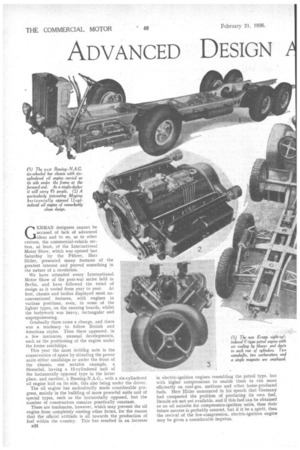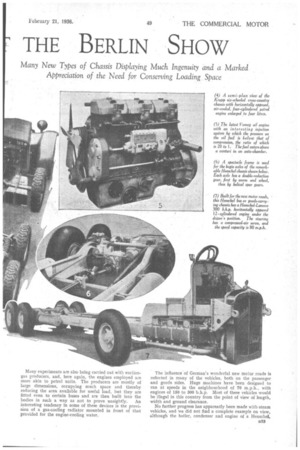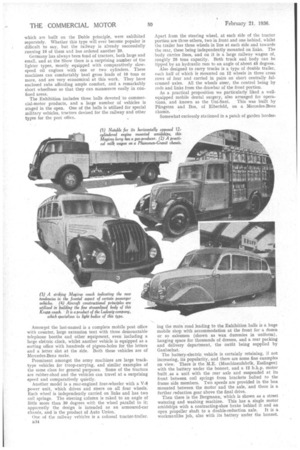ADVANCED DESIGN
Page 46

Page 47

Page 48

Page 49

If you've noticed an error in this article please click here to report it so we can fix it.
THE BERLIN SHOW
Many New Types of Chassis Displaying Much Ingenuity and a Marked Appreciation of the Need for Conserving Loading Space GERMAN designers cannot be accused of lack of advanced ideas and to us, as to other visitors, the commercial-vehicle section, at least, of the International Motor Show, which was opened last Saturday by the Ffthrer, Herr Hitler, presented many features of the greatest interest and proved something in the nature of a revelation.
We have attended every International Motor Show of the post-war series held in Berlin, and have followed the trend of design as it varied from year to year. At first, chassis and bodies displayed most unconventional features, with engines in various positions, even, in some of the lighter types, on the running boards, whilst the bodywork was heavy, rectangular and unprepossessing.
Gradually there came a change, and there was a tendency to follow British and American styles. Then there appeared, in a few instances, unusual developments, such as the positioning of the engine under the frame amidships.
This year the most striking note is the conservation of space by situating the power units either amidships or under the front of the chassis, one notable example, a Henschel, having a 12-cylindered unit of the horizontally opposed type in the latter place, and another, a Bussing-N.A.G., with a six-cylindered oil engine laid on its side, this also being under the driver.
The oil engine has undoubtedly made considerable progress, mainly in the building of more powerful units and of special types, such as the horizontally opposed, but the number of constructors remains practically constant.
There are tendencies, however, which may prevent the oil engine from completely ousting other forms, for the reason that the official attitude is all towards the production of fuel within the country. This has resulted in an increase B32 in electric-ignition engines resembling the petrol type, but with higher compressions to enable them to run more efficiently on coal-gas, methane and other home-produced fuels. Herr Hitler announced in his speech that Germany had conquered the problem of producing its own fuel. Details are not yet available, and if this fuel can be obtained as an oil suitable for compression-ignition units, then their future success is probably assured, but if it be a spirit, then the revival of the low-compression, electric-ignition engine may be given a considerable impetus. Many experiments are also being carried out with suctiongas producers, and, here again, the engines employed are more akin to petrol units. The producers are mostly of large dimensions, occupying much space and thereby reducing the area available for useful load, but they are fitted even to certain buses and are then built into the bodies in such a way as not to prove unsightly. An interesting tendency in some of these devices is the provision of a gas-cooling radiator mounted in front of that provided for the engine-cooling water. The influence of German's wonderful new motor roads is reflected in many of the vehicles, both on the passenger and goods sides. Huge machines have been designed to run at speeds in the neighbourhood of 70 m.p.h., with engines of 150 to 300 bap. Most of these vehicles would be illegal in this country from the point of view of length, width and ground clearance.
No further progress has apparently been made with.steam vehicles, and we did not find a complete example on view, although the boiler, condenser and engine of a Henschel, B33
which arc built on the Doble principle, were exhibited separately. Whether this type will ever become popular is difficult to say, but the railway is already successfully running 10 of them and has ordered another 20.
Germany has always been fond of tractors, both large and small, and at the Show there is a surprising number of the lighter types, mostly equipped with comparatively slowspeed oil engines with one or two cylinders. These machines can comfortably haul gross loads of 10 tons or more, and are very economical at this work. They have enclosed cabs affording ample comfort, and a remarkably short wheelbase so that they can manoeuvre easily in confined areas.
The Exhibition includes three halls devoted to commercial-motor products, and a large number of vehicles is staged in the open. One of the halls is utilized for special military vehicles, tractors devised for the railway an.d other types for the post office.
Amongst the last-named is a complete mobile post office with counter, large extension tent with three demountable telephone booths and other equipment, even including a large electric clock, whilst another vehicle is equipped as a sorting office with hundreds of pigeon-holes for the letters and a letter slot at the side. Both these vehicles are of Mercedes-Benz make.
Prominent amongst the army machines are large tracktype vehicles for troop-carrying, and similar examples of the same class for general purposes. Some of the tractors are rubber-shod and the vehicles can travel at a surprising speed and comparatively quietly.
Another model is a rear-engined four-wheeler with a V-8 power unit, which drives and steers on all four wheels. Each wheel is independently carried on links and has two coil springs. The steering column is raked to an angle of little more than 30 degrees with the wheel parallel to it; apparently the design is intended as an armoured-car chassis, and is the product of Auto Union.
One of the railway vehicles is a colossal tractor-trailer. B34
Apart from the steering wheel, at each side of the tractor portion are three others, two in front and one behind, whilst the trailer has three wheels in line at each side and towards the rear, these being independently mounted on links. The body carries lines, and on it is a large railway wagon of, roughly 20 tons capacity. Both truck and body can be tipped by an hydraulic ram to an angle of about 45 degrees.
Also designed to carry trucks is a type of double trailer, each half of which is mounted on 12 wheels in three cross rows of four and carried in pairs on short centrally fulcrumed axles. All the wheels steer, the control being by rods and links from the drawbar of the front portion.
As a practical proposition we particularly liked a wellequipped mobile dental surgery, also arranged for opera tions, and known as the TJni-Sani. This was built by Pfingsten and Bos, of Elberfeld, on a Mercedes-Benz chassis. '
Somewhat curiously stationed in a patch of garden border jug the main road leading to the Exhibition halls is a huge mobile shop with accommodation at the front for a dozen or so salesmen (shown as wax dummies in uniform), hanging space for thousands of dresses, and a rear packing and delivery department, the outfit being supplied by Gaubschat.
The battery-electric vehicle is certainly retaining, if not increasing, its popularity, and there are some fine examples on view. There is the M.E. (Maschineafabrik, Esslingen) with the battery under the bonnet, and a 12 b.h.p. motor built as a unit with the rear axle and suspended at its front between coil springs from brackets bolted to the frame side members. Two speeds are provided in the box mounted between the motor and the axle, and there is a further seduction gear above the final drive. Then there is the Bergmann, which is shown as a street watering and washing machine. This has a single motor amidships with a contracting-shoe brake behind it and an open propeller shaft to a double-reduction axle. It is a workmanlike job, also with its battery under the bonnet. Hansa-Lloyd stages a 5-ton electric with the resistances, etc., under the front bonnet, and the motor in the place usually occupied by the gearbox of an ordinary vehicle. This has a contracting-shoe brake and Lockheed operation of the wheel brakes. The batteries are supported at the sides. Other vehicles of the electric type are staged by A.E.G. and Bleichert.
Perhaps the most interesting development in injection systems for oil engines is to be found in the new Vomag engine. This operates on the Thomas and Stuhr system. There are no nozzles, and the fuel is fed into the antechambers under a pressure considerably below that of compression, discharge taking place through a 2-mm. open pipe containing a simple non-return valve and connected to the ordinary fuel-injection puinp. The inlet for the fuel in each ante-chamber is just above a venturi, and as the air resulting from compression rushes through the venturi it sweeps the fuel into the chamber. This engine, with a compression ratio of 20 to 1, is said to work very smoothly. The fuel injection is somewhat after the principle of a scent spray.
The big developments in the use of oil engines by Magirus are partly due to this concern's association with Humboldt-Deutz. The Magirus 12-cylindered horizontally opposed, engine has a bore and stroke of 95 mm. and 125 min. respectively, giving 10,532 c.c.; it develops 150 b.h.p. at 2,000 r.p.m., and has a compression ratio of 19.5 to 1.
The outstanding Henschel engine, to which we have alread3r referred,, has 12 , cylinders, develops 300 b.h.p. at 1,500 r.p.M., and has a capacity of 30 litres. This engine
is a Henschel-Lanova. To assist the driver, the mashMe has servo steering, in which the two valves for the control of the compressed air in the servo are electrically operated from the steering column, the contacts being arranged just below the wheel. The gearbox of the constant-mesh pattern gives two normal and two over-drive ratios, also a very low ratio known as the mountain gear. The forward portion of the propeller shaft is carried an two bearings, and two extension sections lead to the first bogie axle, whilst a cardan shaft is provided between these axles. The rearspring seatings on the axles are of a flexible and shockreducing pattern embodying a larger number of rubber and canvas discs. The axles work in a chassis frame of the spectacle type, and circular rubber buffers on them prevent any shock between the axles and frame. Each axle is driven by an overhead worm with a differential in the worm wheel. These drive short shafts carrying helical gears, which mesh with others on the wheel shafts. An unusual feature is the provision of two hand-brake levers. One takes up the main slack, and the second brings the brakes into operation, thus avoiding loss of leverage. This. vehicle, which has a speed of 125 kiloms. per hour (about 80 m.p.h.) is intended to carry single-seater bodies for 60 persons, or, as a goods vehicle, 10-ton Day-loads.
One Magirus lorry with 12-cylindered flat engine situated amidships has a Deutz gas producer mounted behind the cab. It is 'intended for 61-ton loads. In buses of this make the Motor can be positioned at the back.




























































































